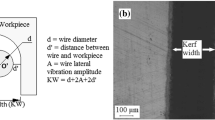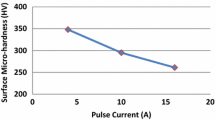Abstract
The unconventional wire electric discharge machining (WEDM) technology represents a vital manufacturing technology in different industrial branches. This technology is essential because of the possibility to machine difficult-to-machine materials such as sintered carbides. For this reason, this study analyses the machinability of sintered carbides WKP23S, WSM33S and WK1 with WEDM in both water and oil baths. We investigated the influence of the machining parameters, namely, pulse off time, gap voltage, discharge current, pulse on time and wire feed, on the cutting speed, surface roughness and defect occurrence. We investigated 9 different roughness parameters, analysed surface morphology with an electron microscope and also analysed cross-sectioned samples. We found out that machining sintered carbides in oil bath yields better results than machining in deionized water. The oil tank prevents the removal of the cobalt binder, but it does not reduce fissure occurrence in any significant way. The lowest Ra value, that is 0.7 µm, was recorded for the WKP23S sample when machined in oil and Ra 0.9 µm when the same material was machined in water.







Similar content being viewed by others
References
Vijayabhaskar S, Rajmohan T, Sisir TP, Abishek JP, Reddy RM (2018) Review of WEDM studies on metal matrix composites. In IOP Con Ser Mater Sci Eng 390(1):012051
Ho KH, Newman ST, Rahimifard S, Allen RD (2004) State of the art in wire electrical discharge machining (WEDM). Int J Mach Tools Manuf 44(12–13):1247–1259
Asgar ME, Singholi AKS (2018) Parameter study and optimization of WEDM process: a review. In IOP Con Ser Mater Sci Eng 404(1):012007
Jung J, Kang S (2007) Sintered (Ti, W) C Carbides. Scripta Mater 56(7):561–564
Kim CH, Kruth JP (2001) Influence of the electrical conductivity of dielectric on WEDM of sintered carbide. KSME Int J 15(12):1676–1682
Pramanick A, Dey PP, Das PK (2020) Microstructure, phase and electrical conductivity analyses of spark plasma sintered boron carbide machined with WEDM. Ceram Int 46(3):2887–2894
Pramanick A, Mandal S, Dey PP, Das PK (2021) Comparative analysis for the prediction of WEDM responses for machining spark plasma sintered boron carbide ceramic sample by RSM and ANFIS. Mater Today Proc 41:1089–1095
Pramanick A, Kumar R, Mandal S, Dey PP, Das PK (2018) Modeling and multi-objective optimization of WEDM of spark plasma sintered boron carbide considering preferences of users. In IOP Con Ser Mater Sci Eng 377(1):012094
Jangra K, Grover S, Aggarwal A (2012) Optimization of multi machining characteristics in WEDM of WC-5.3% Co composite using integrated approach of Taguchi, GRA and entropy method. Front Mech Eng 7(3):288–299
Poroś D, Zaborski S, Stechnij T (2018) Analysis of WEDM application to cutting tools manufacturing for manual shaping of flat surfaces. In AIP Conf Proc 2017(1):020023
Grigoriev S, Volosova M, Grechisnikov V, Pivkin P, Peretyagin P, Zelensky A (2020) Wire electrical discharge machining of Al2O3-TiC in mineral oil and water. Procedia CIRP 95:337–342
Jangra K, Grover S, Chan FT, Aggarwal A (2011) Digraph and matrix method to evaluate the machinability of tungsten carbide composite with wire EDM. Int J Adv Manuf Technol 56(9):959–974
Delgado YP, Bonny K, De Baets P, Neis PD, Malek O, Vleugels J, Lauwers B (2011) Impact of wire-EDM on dry sliding friction and wear of WC-based and ZrO2-based composites. Wear 271(9–10):1951–1961
Akıncıoğlu S (2022) Taguchi optimization of multiple performance characteristics in the electrical discharge machining of the TiGr2. Facta Univ Ser Mech Eng 20(2):237–253
Nas E, Akıncıoğlu S (2019) Optimization of cryogenic treated nickel-based superalloy in terms of electro erosion processing performance. Acad Platf J Eng Sci 7(1):115–126
Przestacki D, Chwalczuk T (2017) The analysis of surface topography during turning of Waspaloy with the application of response surface method. In MATEC Web of Conferences 136:02006
Kawalec M, Przestacki D, Bartkowiak K, Jankowiak M (2008) Laser assisted machining of aluminium composite reinforced by SiC particle. In Int Cong Appl Lasers Electro-Opt 2008(1):1906
Chwalczuk T, Przestacki D, Szablewski P, Felusiak A (2018) Microstructure characterisation of Inconel 718 after laser assisted turning. In MATEC Web of Conferences 188:02004
Kukliński M, Bartkowska A, Przestacki D (2018) Investigation of laser heat treated Monel 400. In MATEC Web of Conferences 219:02005
Mouralova K, Benes L, Zahradnicek R, Bednar J, Hrabec P, Prokes T, Hrdy R (2019) Analysis of cut orientation through half-finished product using WEDM. Mater Manuf Process 34(1):70–82
Mouralova K, Benes L, Prokes T, Bednar J, Zahradnicek R, Fries J (2020) Machining of pure molybdenum using WEDM. Measurement 163:108010
Mouralova K, Benes L, Zahradnicek R, Bednar J, Zadera A, Fries J, Kana V (2020) WEDM used for machining high entropy alloys. Materials 13(21):4823
Klink A, Guo YB, Klocke F (2011) Surface integrity evolution of powder metallurgical tool steel by main cut and finishing trim cuts in wire-EDM. Procedia Eng 19:178–183
Gupta K (2021) Intelligent optimization of wire-EDM parameters for surface roughness and material removal rate while machining WC-Co composite. FME Transactions 49(3):756–763
Muthuraman V, Ramakrishnan R (2012) Multi parametric optimization of WC-Co composites using desirability approach. Procedia Eng 38:3381–3390
Ishfaq K, Ahmed N (2019) WEDM of layered composite: analyzing material removal and cut quality issues. Mater Manuf Process 34(10):1073–1082
Kumar A, Kumar V, Kumar J (2016) Surface crack density and recast layer thickness analysis in WEDM process through response surface methodology. Mach Sci Technol 20(2):201–230
Antar MT, Soo SL, Aspinwall DK, Jones D, Perez R (2011) Productivity and workpiece surface integrity when WEDM aerospace alloys using coated wires. Procedia Eng 19:3–8
McGeough JA (1988) Advanced methods of machining. Springer Science & Business Media
Kumar H, Manna A, Kumar R (2018) Modeling and desirability approach-based multi-response optimization of WEDM parameters in machining of aluminum metal matrix composite. J Braz Soc Mech Sci Eng 40(9):1–19
Chaudhari R, Vora JJ, Patel V, Lacalle LLD, Parikh DM (2020) Effect of WEDM process parameters on surface morphology of nitinol shape memory alloy. Materials 13(21):4943
Funding
CzechNanoLab project LM2018110 funded by MEYS CR is gratefully acknowledged for the financial support of the measurements/sample fabrication at CEITEC Nano Research Infrastructure.
This publication is a result of the project CACTU, Reg. No. CZ.02.1.01/0.0/0.0/17_049/0008397, which has been co-financed by European Union from the European Regional Development Fund through the Operational Programme Research, Development and Education.
Author information
Authors and Affiliations
Contributions
Katerina Mouralova: conceptualization, methodology, data curation, writing— original draft preparation, writing— reviewing and editing, supervision. Libor Benes: methodology, data curation, funding acquisition. Tomas Prokes: methodology. Radim Zahradnicek: data curation, Methodology. Jiri Fries: data curation, funding acquisition. Tomas Plichta: data curation.
Corresponding author
Ethics declarations
Conflict of interest
The authors declare that they have no competing interests.
Additional information
Publisher's note
Springer Nature remains neutral with regard to jurisdictional claims in published maps and institutional affiliations.
Rights and permissions
Springer Nature or its licensor (e.g. a society or other partner) holds exclusive rights to this article under a publishing agreement with the author(s) or other rightsholder(s); author self-archiving of the accepted manuscript version of this article is solely governed by the terms of such publishing agreement and applicable law.
About this article
Cite this article
Mouralova, K., Benes, L., Prokes, T. et al. Analysis of the machinability of different types of sintered carbides with WEDM in both water and oil baths. Int J Adv Manuf Technol 125, 2705–2715 (2023). https://doi.org/10.1007/s00170-023-10913-4
Received:
Accepted:
Published:
Issue Date:
DOI: https://doi.org/10.1007/s00170-023-10913-4




